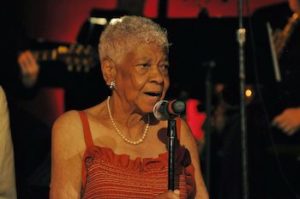
Jeni Le Gon
*Jeni Le Gon was born on this date in 1916. She was a Black dancer and actress.
Born and raised near the south side of Chicago, her musical talents were developed on the street in neighborhood bands and musical groups. At thirteen, buoyed by her brother, who got a job touring as a singer and exhibition ballroom dancer, she landed her first job in musical theatre, dancing as a soubrette in pants, not pretty skirts. Le Gon trained at Mary Bruce's School of Dancing.
By the age of sixteen, she was dancing in a chorus line backed by the Count Basie Orchestra, and soon after, touring as a chorus line dancer with Whitman Sisters, the highest-paid act on the TOBA circuit. This all-Black, woman-managed company was successful in booking themselves continually in leading southern houses and had a reputation for giving hundreds of dancers their first performing break. In the Whitman Sisters’ chorus line, LeGon remembered, “They had all the colors that our race is known for; all the pretty shading from the darkest to the palest of the pale. Each one of us was a distinct-looking kid. It was a rainbow of beautiful girls.” LeGon was one of the first black women in tap dance to develop a career as a soloist. Not a high-heeled dancer in pretty skirts, she was a low-heeled dancer performing toe-stand in pants, and her rigorous combination of flash, acrobatics, and rhythm dancing proved you didn’t have to be a man to dance like a hoofer.
It was while working in Los Angeles, where it was stopping the show for her flips, double spins, knee drips, and toe stands, that LeGon got a part in the 1935 MGM musical, Hooray for Love. As dance partner to Bill Robinson, who she says was a patient teacher and a perfectionist. While working on that movie, she met Fats Waller, with whom she continued to work for much of her career. In 1936, LeGon performed in the London production of C.B. Cochran’s At Home Abroad. She was hailed as one of the brightest spirits, the new Florence Mills, and the “Sepia Cinderella girl who set London agog with her clever dancing.” She was among the few women ever to be invited back to the Hoofer’s Club in New York.
Though primarily a dancer, she sang well and was an appealing, attractive actress when (rarely) given a chance. In Hollywood films 1935-49, her earlier appearances were in specialty dance numbers; later, as with most Black stars of the time, in servant roles. In the forties, Le Gon played leads or second leads in five independently produced all-Black cast films. She appeared as a lead actress on the New York stage periodically (in all-Black productions) and later managed the Dance and Drama Playhouse in Los Angeles. In 1951, after guest appearances on "Amos 'N' Andy," she faded from public view. She toured widely with US Army shows and did club and theater performances nationally and internationally.
In a 1999 documentary by Grant Greshuck, LeGon’s extraordinary devotion to passing on tap dancing was as much a feature of the film as her stardom. Fayard Nicholas, who revered LeGon as a star performer and a gifted teacher who could “do it all,” narrated Living in a Great Big Way, named for one of her famous numbers with Bill Robinson. LeGon said that she saw teaching as a natural extension of her performing, “I’ve had a dance school all my life.” One envies those students for whom she clearly and still labors for the love of the form. Jeni Le Gon died on December 7, 2012.